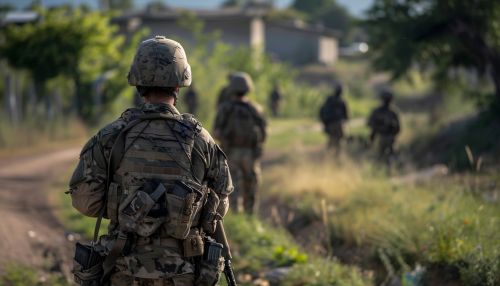Low intensity conflict
Overview
A low-intensity conflict (LIC) is a military conflict, typically in a limited geographic area, that sits below the threshold of conventional warfare and above routine, peaceful competition among states. It often involves protracted struggles of competing principles and ideologies. LIC is characterized by constraints on weaponry, tactics, and levels of violence.
Characteristics
Low-intensity conflicts are often characterized by the following:
- The use of irregular forces: In LIC, regular armed forces often face off against irregular or guerrilla forces. These irregular forces often use asymmetric tactics such as ambushes, sabotage, and raids to offset the conventional superiority of regular forces.
- Political goals: LICs are often driven by political rather than purely military objectives. The conflict may be part of a broader struggle for power or ideological dominance.
- Protracted duration: LICs often last for many years, or even decades. This is because the underlying issues are often deeply rooted and difficult to resolve.
- Limited geographic scope: LICs are often confined to a specific geographic area. This can be a specific region within a country, or a border area between two countries.


Types of Low Intensity Conflict
There are several types of low-intensity conflict, including:
- Insurgencies: This is a rebellion against a constituted authority. Insurgents use irregular military methods and usually have the support of a portion of the local population.
- Terrorist activities: These are violent acts intended to create fear and advance a political, religious, or ideological cause.
- Civil wars: These are armed conflicts between different groups within the same country.
- Ethnic conflicts: These are conflicts between different ethnic or racial groups, often over issues of identity, territory, or power.
- Information wars: These are conflicts where information and propaganda are used as weapons to influence public opinion and decision-making.
Strategies and Tactics
In low-intensity conflicts, both sides often employ a mix of military, political, and psychological strategies. The aim is not just to defeat the enemy militarily, but also to win the 'hearts and minds' of the population.
- Counter-insurgency strategies: These are strategies used by governments to defeat insurgencies. They often involve a mix of military operations and efforts to address the social and political issues that fuel the insurgency.
- Psychological operations: These are operations to convey selected information and indicators to audiences to influence their emotions, motives, objective reasoning, and ultimately the behavior of governments, organizations, groups, and individuals.
- Propaganda campaigns: These are efforts to spread information, especially of a biased or misleading nature, used to promote a political cause or point of view.
Impact and Consequences
Low-intensity conflicts can have a significant impact on the countries and regions where they occur. They can cause human suffering, economic damage, and political instability. They can also have wider implications for regional and international security.
- Humanitarian impact: LICs often result in significant loss of life and displacement of people. They can also lead to human rights abuses and suffering.
- Economic impact: LICs can disrupt economies, destroy infrastructure, and hinder development. They can also create economic opportunities for illicit activities such as smuggling and drug trafficking.
- Political impact: LICs can destabilize governments, lead to changes in political power, and fuel social and ethnic tensions.
- International implications: LICs can spill over into neighboring countries, leading to regional instability. They can also draw in external powers, leading to international tensions.
